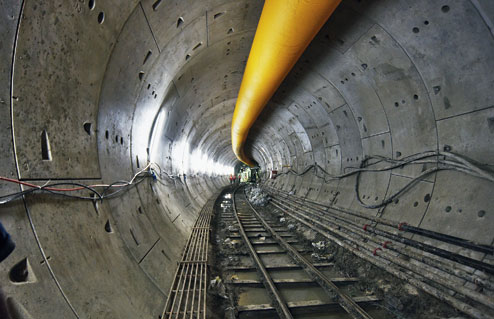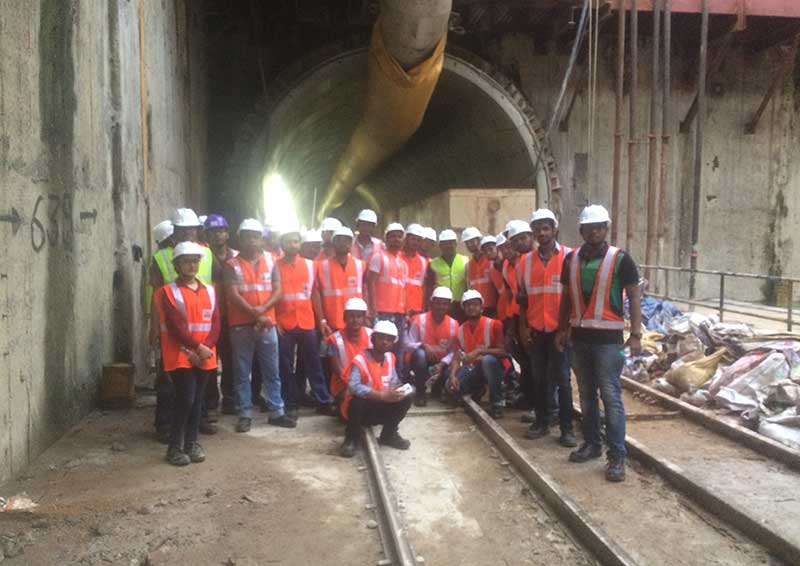East West Metro Tunnel, Calcutta
At least two unique features describe the much awaited underground railway connection between Calcutta (Kolkata) and Howrah, two large cities situated on either side of River Hooghly.
The idea was put forward by a Bengal-born British engineer Sir Harley Hugh Dalrymple-Hay in 1921, and its twin tunnels under River Hooghly are the first of its kind in India.
It has taken almost a century to realise Sir Dalrymple-Hay concept, and it is expected that the East West Metro Railway will have a significant and far reaching impact on Calcutta's transportation system in years to come and the way people commute between these two congested city centres.
In June 2017, 30 members from the ICE Kolkata Chapter visited the tunnels under construction.
The East-West Metro Corridor Project connects the East of Kolkata (Salt Lake Sector-V, Kolkata's IT Hub) with the west end, i.e, Howrah (Kolkata's twin city).
The whole project is being executed by Kolkata Metro Railway Corporation Limited (KMRCL) with partial financial support from JICA.
The entire stretch is divided into three parts:
- UG-1 (underground portion from Howrah Maidan to New Mahakaran).
- UG-2 (underground portion from Esplanade to Subhash Sarobar).
- Elevated portion from Subhash Sarobar to Salt Lake Sector-V.
This UG-1 contract package is being executed by TransTonnelstroy-AFCONS Joint Venture (TTAJV). A consortium (MYCEL) led by AECOM is the General Consultants (GC) to KMRCL.
The works include 2-tier Howrah Maidan Station, one cross-over near Howrah Maidan Station, a 4-tier Howrah Station adjacent to present Howrah Railway Station (Kolkata's Railway Hub to rest of India) to provide interface between underground and surface railway transportation for commuter traffic coming to the cities from suburbs.
Under the project, there are twin 5.5 m tunnels that are 3 km long and a vent shaft/emergency exit on Kolkata's side by Hooghly River.
The tunnels under the river pass through mostly clay silts at a depth of 11-15 m below the river bed and under submergence of 13 m average tide water in the river.
There are EPBM type two Tunnel Boring Machines (TBM) at work from Herrenknecht, Germany (named 'Rachana' meaning 'Composition', and 'Prerana' meaning 'Encouragement').
The tunnel is being constructed with pre-cast segments (5 regular segments and 1 key) of M50 grade concrete along with all necessary arrangement to ensure waterproofing, resistance to earthquake and flotation for a design life of 120 years.
During tunnelling (other than utilities and land issues), the biggest challenge is to ensure the safety of buildings and structures above ground (some of them are almost a century old and remnants of the colonial era) with suitable preventive measures.
Tunnels have successfully crossed Howrah DRM building with nominal damage and it is considered to be one of the key achievements in this project.
This article was originally published here by ICE on 15 June 2017. It was written by Ayanangshu Dey.
--The Institution of Civil Engineers
[edit] Related articles on Designing Buildings Wiki
- Articles by ICE on Designing Buildings Wiki.
- Excavating plant.
- From Calcutta to Kolkata - legacy and modernisation.
- India looks at using plastic instead of sand.
- India needs to build more infrastructure fast. Here's how.
- Indian construction industry.
- Indian infrastructure.
- Follo Line, Norway.
- Stad Ship Tunnel.
- Trenchless technology.
- Tunnel Engineering Exhibition 2017.
- Tunnelling.
- Tunnels of the world.
- Underpinning.
Featured articles and news
International Electrician Day, 10 June 2025
Celebrating the role of electrical engineers from André-Marie Amperè, today and for the future.
New guide for clients launched at Houses of Parliament
'There has never been a more important time for clients to step up and ...ask the right questions'
The impact of recycled slate tiles
Innovation across the decades.
EPC changes for existing buildings
Changes and their context as the new RdSAP methodology comes into use from 15 June.
Skills England publishes Sector skills needs assessments
Priority areas relating to the built environment highlighted and described in brief.
BSRIA HVAC Market Watch - May 2025 Edition
Heat Pump Market Outlook: Policy, Performance & Refrigerant Trends for 2025–2028.
Committing to EDI in construction with CIOB
Built Environment professional bodies deepen commitment to EDI with two new signatories: CIAT and CICES.
Government Grenfell progress report at a glance
Line by line recomendation overview, with links to more details.
An engaging and lively review of his professional life.
Sustainable heating for listed buildings
A problem that needs to be approached intelligently.
50th Golden anniversary ECA Edmundson apprentice award
Deadline for entries has been extended to Friday 27 June, so don't miss out!
CIAT at the London Festival of Architecture
Designing for Everyone: Breaking Barriers in Inclusive Architecture.
Mixed reactions to apprenticeship and skills reform 2025
A 'welcome shift' for some and a 'backwards step' for others.
Licensing construction in the UK
As the latest report and proposal to licence builders reaches Parliament.
Building Safety Alliance golden thread guidance
Extensive excel checklist of information with guidance document freely accessible.
Fair Payment Code and other payment initiatives
For fair and late payments, need to work together to add value.
Pre-planning delivery programmes and delay penalties
Proposed for housebuilders in government reform: Speeding Up Build Out.
High street health: converting a building for healthcare uses
The benefits of health centres acting as new anchor sites in the high street.



























